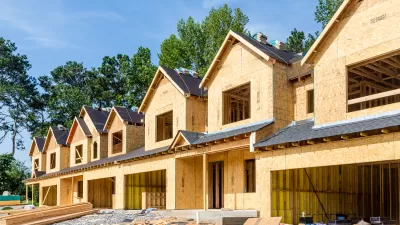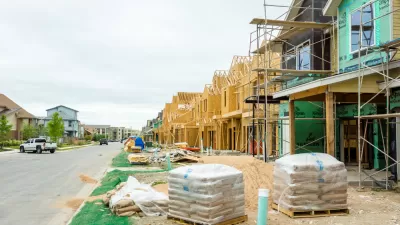Australia's housing market has built steadily at market rates but housing affordability has remained steady. What if building waves of new supply isn't enough to improve affordable housing options for those in need?

An article with a small committee of writers, and published by The Conversation, aims to debunk policy clichés "that keep reemerging" in the face of Australia's affordable housing shortage.
To put it simply, this article is taking aim at supply side approaches to housing policy—i.e., loosening zoning to allow for more building. In Australia, according to this article, supply is booming, but that hasn't helped lower housing costs.
Australia’s new housing supply per capita is actually very strong by international standards. Over the past decade, supply of new units and apartments has been flowing in job-rich metropolitan areas with dense populations, which are also higher-value locations.
According to the cliché, this supply response should have cooled prices. Yet dwelling price inflation has surged even in metropolitan areas where new housing supply has exceeded population growth.
The article also takes aim at the notion of filtering, "whereby older housing moves down to the affordable end of the market over time." The authors claim that the evidence for filtering is thin in the United States. As for in Australia: "in Australia there’s still no evidence to suggest new housing supply has filtered across the housing stock to expand affordable housing opportunities for low-income Australians, or that it will do so any time soon."
The authors also argue that builders would stop building as soon as prices did cool, so "high levels of supply output are rarely sustained." All of these arguments lead to the conclusion that planning reform is inadequate as affordable housing strategy. The only solution, according to the article, is a larger affordable housing sector.
FULL STORY: Affordable housing policy failure still being fuelled by flawed analysis

Planetizen Federal Action Tracker
A weekly monitor of how Trump’s orders and actions are impacting planners and planning in America.

San Francisco's School District Spent $105M To Build Affordable Housing for Teachers — And That's Just the Beginning
SFUSD joins a growing list of school districts using their land holdings to address housing affordability challenges faced by their own employees.

The Tiny, Adorable $7,000 Car Turning Japan Onto EVs
The single seat Mibot charges from a regular plug as quickly as an iPad, and is about half the price of an average EV.

Seattle's Plan for Adopting Driverless Cars
Equity, safety, accessibility and affordability are front of mind as the city prepares for robotaxis and other autonomous vehicles.

As Trump Phases Out FEMA, Is It Time to Flee the Floodplains?
With less federal funding available for disaster relief efforts, the need to relocate at-risk communities is more urgent than ever.

With Protected Lanes, 460% More People Commute by Bike
For those needing more ammo, more data proving what we already knew is here.
Urban Design for Planners 1: Software Tools
This six-course series explores essential urban design concepts using open source software and equips planners with the tools they need to participate fully in the urban design process.
Planning for Universal Design
Learn the tools for implementing Universal Design in planning regulations.
Smith Gee Studio
City of Charlotte
City of Camden Redevelopment Agency
City of Astoria
Transportation Research & Education Center (TREC) at Portland State University
US High Speed Rail Association
City of Camden Redevelopment Agency
Municipality of Princeton (NJ)





























